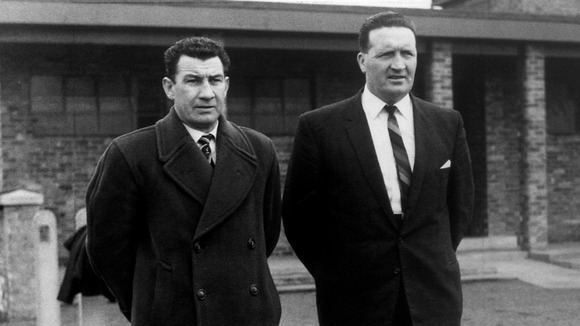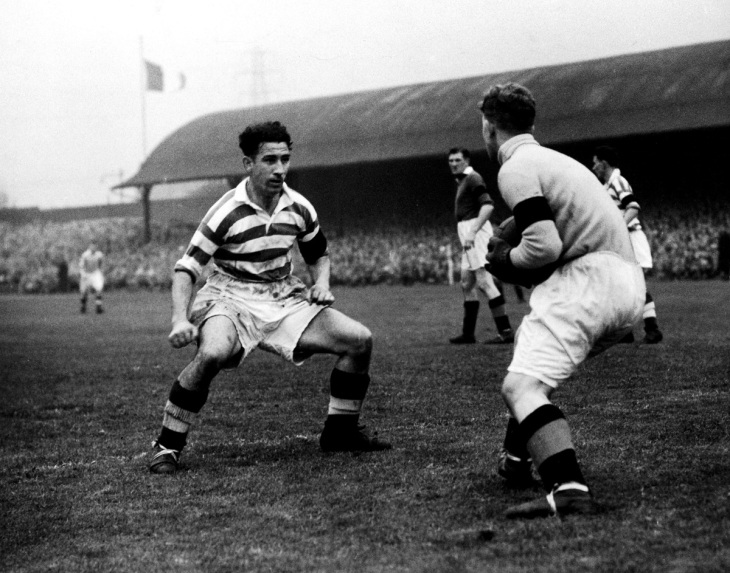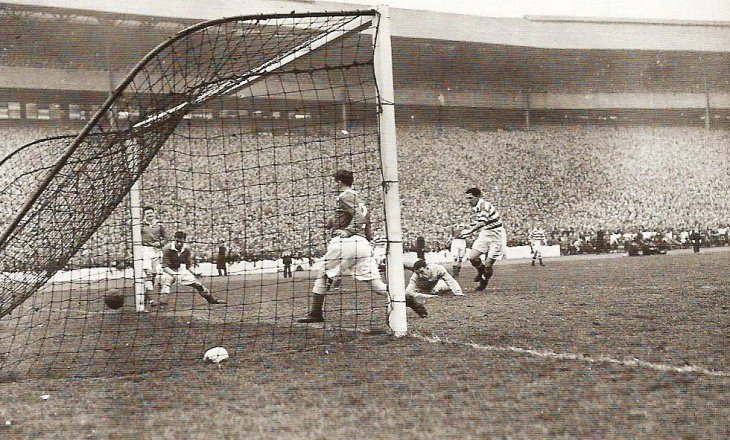Over the past 50 years, the story of the Lisbon Lions has been told and retold. Everyone knows the fairy tale: that 11 Scots, all born within a 30-mile radius of Celtic Park, became the first British and non-Latin team to win the European Cup. And everyone knows that Jock Stein was the man responsible.
In apportioning glory, Stein – one of the game’s greatest managers and the driving force behind Celtic’s finest team – fully merits the lion’s share. Yet in the rush to acclaim Big Jock as the architect of Lisbon and the club’s glory years of the 1960s and ‘70s, there has been a tendency to overlook the man who helped him work miracles. That man was his influential assistant, Sean Fallon.
As John Gorman, who played under the duo, said: “I think an image has developed, particularly since he passed away, that Jock did it all by himself at Celtic. Part of that has been the diminishing of Sean’s role, and that really annoys me. Because he was a lot more than just Jock’s helper.”
Gorman and his Celtic team-mates saw that that their manager, while undoubtedly a genius, was not without his flaws. Had Stein’s weaknesses not been his assistant’s strengths, the club’s glory days would not have been nearly as glorious. “Quite honestly,” said Billy McNeill, “Jock – for all his qualities – needed Sean. He was able to supply all the things the big man wasn’t particularly good at.”

Stein, to his immense credit, recognised this. He afforded Fallon the trust and freedom needed to maximise his attributes, and it resulted in one of the greatest managerial partnerships of all time. “You’re talking about Celtic’s greatest manager and greatest assistant manager together,” said Davie Hay. “Both had their own qualities but they complemented each other brilliantly and I always admired Sean for the way he played his role. He was a vital cog in the machine during those great years for Celtic but the fact he didn’t get much recognition for that didn’t seem to bother him.”
The Irishman himself, speaking in his authorised biography, ‘Sean Fallon: Celtic’s Iron Man’, confirmed this to be the case. “I knew at the time that a lot of my work was going unnoticed, but I wasn’t in the job for recognition,” he said. “The way I saw it, my job was to help the club and to help Jock and the players, and I tried to do that as best I could. I never think: ‘Ah, I’m annoyed I didn’t get credit for this or for that.’ Not at all. I just look back on what the club achieved and feel lucky to have been a part of it.
“I had a few offers over the years to become manager at other clubs but Jock stopped me from going and said he needed me at Celtic. And I never wanted to leave the club anyway. That might not have been the case if someone else was in charge. I don’t think you could do the job of assistant if you didn’t believe completely in the person you were working with. But I was fortunate to work with one of the greats; someone who knew the game inside-out but also respected my opinion.”
And Fallon’s was an opinion well worth respecting. Stein had seen and appreciated that when the two played together, and later recognised that his old friend had an unparalleled eye for talent. “If I liked a player, Jock trusted me enough to let me get on with it,” said the Irishman. “People say I had an eye for talent and, without being too immodest, I do think that was a strength I had. My record was pretty good.”
It was a great deal better than that. When Celtic’s polled their fans in 2002 for the club’s best-ever team, over half the players selected – from across the club’s illustrious history – were Fallon signings.
Names such as Dalglish, McGrain, Macari, Connelly, Hay, Burns, Bonner and McStay, all brought to Celtic by the Irishman, establish him as one of the greatest talent-spotters British football has ever seen. And that is before we consider his contribution to the Lisbon Lions.
Luring legends
Stein undoubtedly provided the magic touch, and had no bigger admirer than his assistant. “Jock was a great manager,” enthused Fallon. “A master. People talk about the greatest managers of all time and I still believe that Jock is at least on a par with the best of them. There are so many things that go towards making a great manager and, to me, Jock had them all.”
But even the best managers stand or fall on the quality of players at their disposal, and this was where Stein was indebted to his assistant. For while Big Jock was a magnificent motivator and an insightful tactician, he did not possess Fallon’s uncanny knack for identifying and acquiring talent.
It is common knowledge that just one of the Lisbon Lions – striker Willie Wallace – was signed by Stein. Less well known is the role Fallon played in assembling the others, and in convincing Big Jock to hold on to the greatest of them all.

Indeed, while the Irishman’s most famous signing involved the snatching of Rangers fanatic Kenny Dalglish, equally significant was the success he enjoyed in keeping Tommy Gemmell and Bobby Murdoch from Motherwell. Gemmell had wanted nothing more than to pull on the claret-and-amber of his hometown club, describing them in his autobiography as “the one team I wanted to play for”. Motherwell, though, seemed oblivious to the potential Fallon quickly identified. The Irishman would be at Gemmell’s side at Celtic Park on October 25, 1961 when, along with another young hopeful by the name of Jimmy Johnstone, he signed his first contract.
In Murdoch’s case, Motherwell had taken the then remarkable step of offering the youngster, who was just 14, a full-time contract at the not inconsiderable wage of £8-a-week. But Fallon visited his house and charmed Bobby’s parents, convincing them that their son would be in capable and caring hands at Celtic Park.
“There isn’t a better feeling in football than signing a young lad and then seeing him go on to enjoy great success,” said Fallon. “And with Tommy and Bobby, they couldn’t have done any more. I always felt that Bobby wasn’t as famous around the world as he should have been in those great days. He was a magnificent natural footballer, and someone with the ability to control and dictate matches. A lovely lad too. He never gave Jock and myself a minute’s trouble.
“Tommy was cheekier and more sure of himself, but he was a tremendous player. He was quick, good in the air and his support play for our attacks was such a great weapon. He was a magnificent striker of the ball – one of the best around – and there aren’t many full-backs who can say they’ve scored in two European Cup finals.”
Kelly Kids to Lisbon Lions
Jim Craig, Gemmell’s fellow full-back – and the man who set up his equaliser in Lisbon – was another Fallon signing. He quickly recognised that he had been recruited by a talent-spotter supreme. “There’s no doubt that was one of Sean’s great talents,” Craig said. “He had an obvious eye for a player and a good set of contacts about the country who would give him a nod when they’d seen someone worth a second look. Sean seemed to make the right call more often than not. The signings he made brought Celtic a lot of success, and a lot of money.”
It should not be forgotten, though, that many of these talented youngsters and future Lisbon Lions struggled badly during their early years with the club. Murdoch, for example, was routinely jeered during the lean years of the early ‘60s as chairman Bob Kelly embarked on an ill-advised bid to copy Manchester United’s Busby Babes. The side’s nickname, the Kelly Kids, reflected the knowledge that the chairman was responsible not only for Celtic’s erratic team selections, but the costly decision to sell senior stars such as Bobby Collins and Pat Crerand.
In the absence of such figures, the club’s youngsters wilted. Fallon, who had been assisting McGrory and was growing in influence, told Kelly that an injection of experience and personality was urgently required. He eventually succeeded in convincing the chairman to reluctantly sanction two of the most significant signings in Celtic’s history.

The first was a goalkeeper who had been in the senior game three years longer than Fallon himself, having debuted for Queen’s Park in 1945. He had enjoyed a sterling career, but it was a career drawing to a close. A fall-out with Stein, his then manager at Hibernian, had caused the veteran keeper to look at a life outside football, and he had even begun reporting on matches for a Sunday newspaper.
“I remember the reaction I got when I suggested signing Ronnie,” recalled Fallon. “Everyone said, ‘But he’s finished. What are you thinking?’ The chairman went along with it in the end – probably because Ronnie was cheap. Jock was looking for £4,000 but I told him we only wanted Ronnie for the reserves and bartered him down to £2,000. What I said about the reserves wasn’t strictly true, but Jock forgave me for it. He had already given Ronnie permission to talk to Berwick Rangers about becoming their manager at that time. But I knew that he still had a lot to offer as a player.”
That same keeper, who had been choosing between journalism and Berwick Rangers, went on to make almost 200 appearances for Celtic. In the club’s glory year of 1967, it was not Murdoch, McNeill or Johnstone, but rather the 36-year-old Simpson, who was voted Scotland’s Player of the Year.
By acquiring a priceless assett for such a modest fee, Fallon had proved himself a shrewd operator in the transfer market. He did, however, stretch Kelly’s faith to its very limit with his next request. Bertie Auld was, after all, a player the chairman had been glad to rid himself of four years earlier, and little had happened to change his mind in the years since. Familiar flashes of temper had followed Auld to Birmingham City, where his most famous contribution came in delivering knockout punches to two Fulham players within seconds of each other. But Fallon firmly believed that Auld – both as a player and a personality – was desperately needed, and worth fighting for.
“I had to plead with the chairman before he finally agreed,” he recalled. “But I kept at him because I knew Bertie would make all the difference. He was an older head; tough and cunning. And he could play – Bertie could take three players out of the game with a single pass. I knew he’d put his foot on the ball and slow things down for us because our football at that time was too fast and furious. Bertie knew how good he was – he fancied himself rotten – and we needed that kind of self-belief at the time.”
Willie Wallace would later describe Auld as the Lisbon Lions’ “best player”. “He simply made the team tick,” the striker explained. “He was our general.” The team’s maverick, though, and the darling of the fans, was of course the one and only Jimmy Johnstone. And though Stein would come to love the winger like a wayward son, he was a late convert. Shortly after taking charge, he presented the board with a list of players he wanted to offload. Jinky’s was among the names scribbled down.
“It took Jock a while to realise how good some of our players were when he first came in,” Fallon recalled. “I had to try to talk him round on a few of them, Jinky included. Jock wasn’t convinced at first – he thought Jinky was too much of an individual, not a team player – but he ended up loving him. It just took him a while. Everyone can make mistakes, though – even the best managers in the game.”
Fortunately for Celtic, Stein didn’t make many. And of all his wise decisions, perhaps the shrewdest of all was picking Fallon to be his assistant.
Article first published in the Scottish Daily Mail on 24.05.17









